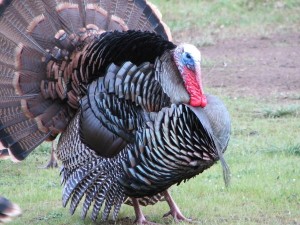Spring Turkey season is almost upon us and I’m starting to prepare for an upcoming turkey hunt Memorial Day weekend. I’ve never seriously hunted turkey prior to this year, so I will be spending a lot of time learning and preparing for my turkey hunt over the next few weeks. As a result, my next few articles will be detailing my planning and preparation for the upcoming turkey season.
Shotgun and Ammunition
The first thing the typical turkey hunter needs is a shotgun. Virtually any full-choke 12 gauge shotgun will do, though some hunters are successful using 16 and 20 gauge shotguns.
If you’d like to learn more about the different shotgun gauges, read the article below:
Shotgun Gauges Explained: 10 vs 12 vs 16 vs 20 vs 28 vs 410
Most of the major ammunition manufacturers make special copper plated lead shots designed for turkey hunting in size 4, 5, or 6 shot. While the exact brand and size of your shot does not matter very much, it is extremely important to learn how your shotgun “patterns” with a given load before heading out into the woods.
Start by purchasing a few different brands of turkey hunting ammunition in different sizes. Then, trace the outline of a gobbler’s head and neck on a large piece of cardboard or buy a special target with a turkey head already on it. Place the cardboard about 20 yards downrange and fire one shot with one of your potential hunting loads. Ideally, you should hit the head and neck of the target with at least 12-15 pellets.
Repeat the exercise at 30 and 40 yards and with each of the different ammunition brands and shot sizes to see how effective your gun is at each range and to see which load works best in your shotgun. Once the number of pellets striking the head and neck drops below 12, then you have exceeded the maximum recommended range for that particular load. You should also check the shot pattern to make sure it is distributed evenly and that there are no open spaces or “voids” in the pattern. Any void the size of a fist or larger is unacceptable and could cause you to miss or wound a turkey during a hunt.
Turkey Hunting Calls
Box calls are easy to master and produce sound by moving the lid of the call over the thin side edges below it. A hunter should carry a number of turkey calls. Besides box calls, there are slate calls, mouth calls (diaphragms), and pushbutton calls. The pushbutton is another easily learned call that can replicate the yelps, clucks, and purrs of a hen. Find out which type of call works best for you and be sure to perfect it before the season starts.
Camouflage
Once you’ve mastered your call, be sure to outfit yourself so birds can’t spot you. Unlike deer, turkeys have a very poor sense of smell. Instead, they rely on their phenomenal eyesight, which makes full camouflage clothing essential for the hunter. Use a head net or face paint to deaden the shine of your face. Wear gloves as a turkey can readily identify the movement of your hands as you set down the call and raise your shotgun.
While thinking about camouflage, don’t forget about your shotgun. Any reflective finish can spook a wary bird. You can minimize glare and break up its outline by adding some camouflage to your shotgun. You might also want to have a Turkey Vest to keep all your gear close at hand (they make great gifts for hunters). The pockets are great for holding extra shells, calls, and snacks. However, the most important feature of the turkey vest is the cushioned seat!
Finding Turkeys
Turkeys need wide openings and clear spaces to feel comfortable. Thick brush can hide predators, so they tend to avoid these areas. Look for good hunting in mature pine forests adjacent to open areas. Turkeys like grassy slopes and meadows because of the food available to them like fresh greens, seed heads, and bugs.
Look for turkey signs to help you choose a hunting area. If turkeys are in the area, they will have used the roads to travel. Try driving logging roads and walking wide game trails in turkey country. Look for droppings, tracks and feathers. If there are birds in the area, you will find their sign. If you don’t spot any sign, keep moving along until you do.
As you can see, the basics of turkey hunting are pretty simple. However, putting it all together is not always as easy as it looks. Be sure to check out my next few articles as I detail my next few steps of learning how to turkey hunt.
Make sure you follow The Big Game Hunting Blog on Facebook, Instagram, Twitter, and YouTube.
NEXT: BEST 6.5 CREEDMOOR AMMO FOR HUNTING ELK, DEER, AND OTHER BIG GAME
John McAdams is a proficient blogger, experienced shooter, and long time hunter who has pursued big game in 8 different countries on 3 separate continents. John graduated from the United States Military Academy at West Point and is a veteran of combat tours with the US Army in Iraq & Afghanistan. In addition to founding and writing for The Big Game Hunting Blog, John has written for outdoor publications like Bear Hunting Magazine, The Texas State Rifle Association newsletter, Texas Wildlife Magazine, & Wide Open Spaces. Learn more about John here, read some of John’s most popular articles, and be sure to subscribe to his show: the Big Game Hunting Podcast.




Roosting turkeys the night before the hunting is also a great idea, because you’ll know where they are sleeping and where they will be in the morning. Concerning the camouflage, you should never wear anything red, white or blue when turkey hunting.
Awesome Post ! Thank you for sharing